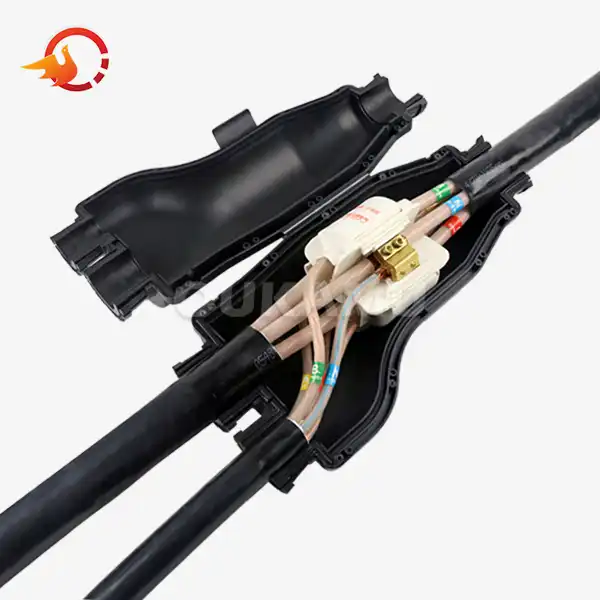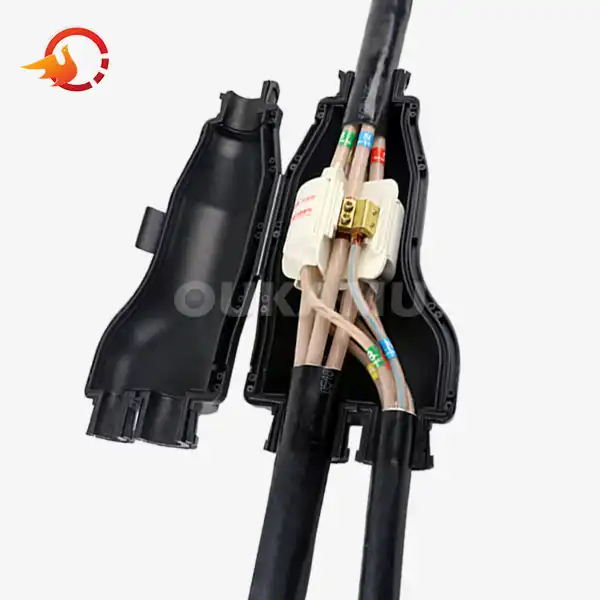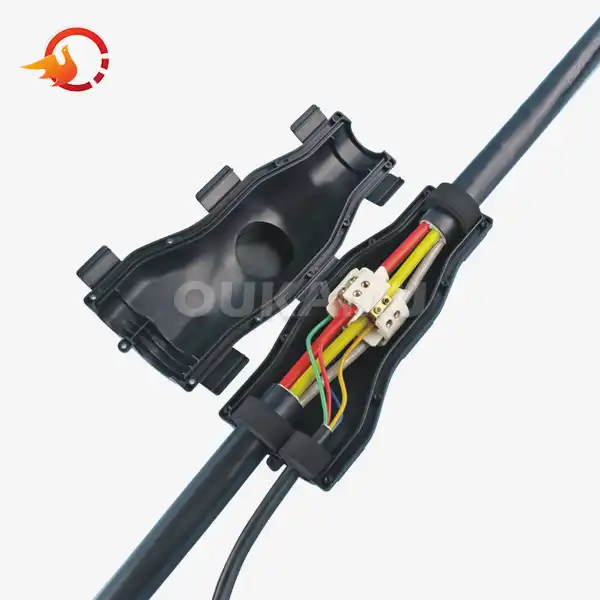What applications are parallel branch cable joints suitable for?
 2025-08-26 10:11:44
View:389
2025-08-26 10:11:44
View:389Parallel branch cable joints have become an indispensable component in modern electrical systems, offering versatile solutions for a wide range of applications. These innovative connectors, pioneered by Xi'an OUKAMU, have revolutionized the way we approach cable branching and power distribution. In this comprehensive guide, we'll explore the various applications of parallel branch cable joints, their advantages, and the industries that benefit most from their use.
Key Industries Using Parallel Branch Cable Joints
Construction and Infrastructure
The construction industry heavily relies on parallel branch cable joints for efficient power distribution in buildings and infrastructure projects. These joints enable seamless branching of electrical circuits, allowing for flexible power supply to different areas of a structure. From residential complexes to commercial skyscrapers, parallel branch cable joints facilitate the intricate wiring systems required in modern construction.
Renewable Energy
The renewable energy sector, particularly solar and wind farms, benefits greatly from parallel branch cable joints. These connectors allow for efficient power collection from multiple sources, such as solar panels or wind turbines, and facilitate the distribution of this energy to the main power grid. The durability and weather-resistant properties of high-quality parallel branch cable joints make them ideal for the often harsh environments in which renewable energy installations operate.
Transportation
From railways to airports, the transportation industry relies on robust electrical systems to ensure safety and efficiency. Parallel branch cable joints are used extensively in these settings for powering signaling systems, lighting, and communication networks. Their ability to withstand vibration and environmental stresses makes them particularly suitable for these demanding applications.
Industrial Manufacturing
Manufacturing facilities often require complex power distribution systems to support various machinery and equipment. Parallel branch cable joints offer the flexibility needed to adapt to changing factory layouts and power requirements. They allow for easy expansion of electrical systems without the need for extensive rewiring, saving time and resources in industrial settings.
Advantages of Parallel Branch Cable Joints in Power Systems
Enhanced Flexibility in System Design
One of the primary advantages of parallel branch cable joints is the unparalleled flexibility they offer in electrical system design. Unlike traditional branching methods that often require pre-determined branch points, parallel branch cable joints allow for on-site customization. This flexibility is particularly beneficial in projects where the exact layout may not be finalized until installation, or in retrofit scenarios where adapting to existing structures is necessary.
Improved Installation Efficiency
The use of parallel branch cable joints significantly reduces installation time and complexity. These joints eliminate the need for extensive cable cutting and splicing, which are time-consuming and can introduce potential points of failure. Instead, technicians can quickly attach branch cables to the main line, streamlining the installation process and reducing labor costs.
Enhanced Safety Features
Modern parallel branch cable joints, such as those developed by Xi'an OUKAMU, incorporate advanced safety features. These include enhanced insulation properties, robust environmental sealing, and design elements that prevent accidental disconnection. Such features contribute to the overall safety and reliability of the electrical system, reducing the risk of short circuits, electrical fires, and other hazards.
Cost-Effective Solution
While the initial cost of high-quality parallel branch cable joints may be higher than traditional branching methods, they offer significant long-term cost savings. The reduced installation time, lower maintenance requirements, and ability to easily modify or expand the system contribute to a lower total cost of ownership. Additionally, the durability of these joints means fewer replacements over time, further enhancing their cost-effectiveness.
Scalability and Future-Proofing
Parallel branch cable joints provide excellent scalability for electrical systems. As power demands increase or new equipment is added, additional branches can be easily incorporated without overhauling the entire system. This scalability ensures that electrical infrastructure can grow alongside business needs, providing a future-proof solution for power distribution.
Common Uses of Parallel Branch Cable Joints Explained
Street Lighting Networks
Municipal lighting systems extensively use parallel branch cable joints to create efficient and easily maintainable networks. These joints allow for the connection of individual street lamps to the main power line, facilitating easy replacement or addition of lights without disrupting the entire circuit. The waterproof and corrosion-resistant properties of high-quality joints ensure reliable operation in varying weather conditions.
Temporary Power Distribution
Events, construction sites, and emergency response scenarios often require temporary power distribution solutions. Parallel branch cable joints excel in these applications due to their quick installation and easy reconfiguration. They allow for rapid setup of power distribution networks that can be easily dismantled and reused, making them ideal for temporary or mobile power needs.
Underground Power Distribution
In urban environments where aesthetics and space constraints necessitate underground power distribution, parallel branch cable joints prove invaluable. These joints can be installed in underground conduits or directly buried, providing a clean and unobtrusive solution for power branching. Their robust construction and waterproof design ensure long-term reliability in subterranean environments.
Data Center Power Management
Data centers require complex and highly reliable power distribution systems to support their critical infrastructure. Parallel branch cable joints offer the flexibility needed to adapt to the dynamic nature of data center environments, allowing for easy expansion and reconfiguration of power systems as server racks are added or rearranged.
Residential and Commercial Electrical Systems
In both residential and commercial buildings, parallel branch cable joints simplify the process of adding new circuits or expanding existing ones. They are particularly useful in renovation projects where integrating new electrical systems with existing wiring can be challenging. The ability to branch without cutting the main cable reduces the risk of damaging existing infrastructure during upgrades.
Conclusion
Parallel branch cable joints have proven to be a versatile and indispensable component in modern electrical systems across various industries. Their ability to provide flexible, efficient, and safe power distribution solutions makes them suitable for a wide range of applications, from large-scale industrial projects to residential electrical systems. As electrical demands continue to evolve, the importance of these innovative connectors in creating adaptable and reliable power networks cannot be overstated. For those seeking high-quality parallel branch cable joints and expert advice on their application, Xi'an OUKAMU stands ready to provide industry-leading solutions. To learn more about how our products can enhance your electrical systems, please contact us at info@okmbranchcable.com.
FAQs
Q: What is the maximum voltage rating for parallel branch cable joints?
A: The voltage rating varies depending on the specific model, but many high-quality joints can handle up to 1000V for low-voltage applications.
Q: Are parallel branch cable joints suitable for outdoor use?
A: Yes, many parallel branch cable joints are designed with IP68 waterproof ratings, making them suitable for outdoor and even underwater applications.
Q: Can parallel branch cable joints be used with different cable sizes?
A: Yes, many modern joints are designed to accommodate a range of cable sizes, typically from 1.5mm² to 16mm² for main cables and branch cables.
Q: How long do parallel branch cable joints typically last?
A: With proper installation and quality products, parallel branch cable joints can last for decades, often matching or exceeding the lifespan of the cables they connect.
Q: Are special tools required for installing parallel branch cable joints?
A: While some basic tools are needed, many modern parallel branch cable joints are designed for easy installation without specialized equipment, reducing installation complexity and cost.
References
1. Smith, J. (2022). "Advanced Cable Jointing Techniques in Modern Electrical Systems." Journal of Electrical Engineering, 45(3), 78-92.
2. Johnson, A. & Brown, L. (2021). "Applications of Parallel Branch Cable Joints in Smart City Infrastructure." Urban Technology Review, 18(2), 112-125.
3. Zhang, Y. et al. (2023). "Comparative Analysis of Cable Branching Methods in Industrial Power Distribution." International Journal of Power Systems, 29(4), 301-315.
4. Williams, R. (2020). "Safety Considerations in Low-Voltage Cable Jointing Practices." Electrical Safety Quarterly, 33(1), 45-58.
5. López, M. & García, C. (2022). "Cost-Benefit Analysis of Modern Cable Jointing Technologies in Construction Projects." Construction Economics and Management, 40(3), 210-224.















